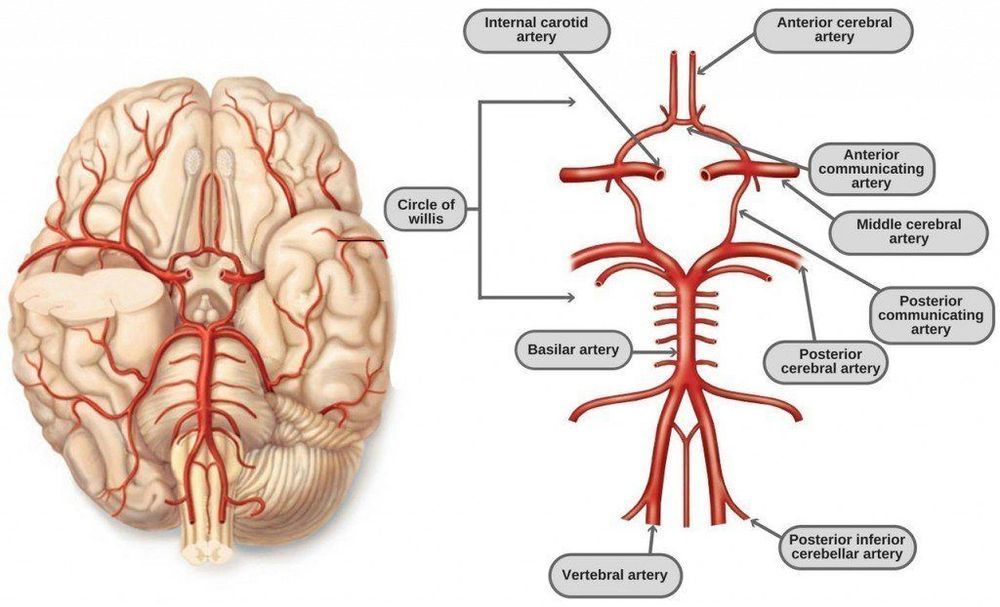But that stirs up a privacy debate.
O.o.
No matter how long you wait, the matter that makes you probably won’t end up inside a black hole.
Los Angeles Power and Water officials have struck a deal on the largest and cheapest solar + battery-storage project in the world, at prices that leave fossil fuels in the dust and may relegate nuclear power to the dustbin.
Later this month the LA Board of Water and Power Commissioners is expected to approve a 25-year contract that will serve 7 percent of the city’s electricity demand at 1.997¢/kwh for solar energy and 1.3¢ for power from batteries.
“This is the lowest solar-photovoltaic price in the United States,” said James Barner, the agency’s manager for strategic initiatives, “and it is the largest and lowest-cost solar and high-capacity battery-storage project in the U.S. and we believe in the world today. So this is, I believe, truly revolutionary in the industry.”
Blood flows into the brain primarily via the carotid arteries and the vertebral arteries. The Circle of Willis is a circular arterial structure in the brain that connects blood flowing in from the carotid arteries with blood flowing in from the basilar artery (which is fed by the vertebral arteries). Blood flows from the Circle of Willis into brain tissue via the anterior, middle, and posterior cerebral arteries. Many studies have shown that the Circle of Willis is incomplete in most people. A 1998 study of 150 healthy adult volunteers showed a complete Circle of Willis in only 42% of cases — more often complete in younger persons and females [RADIOLOGY; Krabbe-Hartkamp, MJ; 207:103–111 (1998)]. A slightly more encouraging 2002 study of 118 healthy volunteers in the 65–68 age group, showed 47% had a complete Circle of Willis [THE JOURNAL OF CARDIOVASCULAR SURGERY; Macchi, C; 43:887–890 (2002)]
For cryonics purposes, it has been believed that perfusion into the carotid arteries, but not into the vertebral arteries will result in incomplete perfusion of the brain if the Circle of Willis is not complete. In particular, if both posterior communicating arteries are missing, then perfusing only through the carotid arteries will result in no blood getting to parts of the brain supplied by the posterior cerebral arteries. Both posterior communicating arteries were missing in 11% of those in the 1998 study and in 14% of those in the 2002 study cited above.
Nonetheless, a 2008 study showing Circle of Willis complete in only 40% of 99 patients found no case of insufficient perfusion in functional tests of patients given unilateral cerebral perfusion. The authors concluded that “extracranial collateral circulation” provides an alternative pathway to the Circle of Willis for cerebral crossperfusion [EUROPEAN JOURNAL OF CARDIOTHORACIC SURGERY; Urbanski, PP; 33:402–408 (2008)]. Although persons with missing posterior communicating arteries could easily have pathways to opposite sides of the brain, other variants of Circle of Willis incompleteness would be expected to prevent perfusion across hemispheres.
So everyone can have fun in the sun this summer.
06/16/2017 04:31pm EDT
Modern day female longsword expert wins the The Longsword Competition at the World Invitationals.
Trained in European martial arts as she puts it (When you think ‘martial arts’ it usually brings up images of Far East fighting styles, so this was interesting to hear European sword fighting described in this way), and using swords that she herself designed (specifically for her style of fighting and longsword competition), Samantha Swords is a girl after my own ‘Geek’ heart.
See her video interview below complete with sword play demonstrations and training…
What are the key driving forces shaping the emerging future of business meetings, events, and conferences?

The next five years promise to bring fundamental changes across society – from the clients we serve, to the technology we use, and the needs and priorities of business – literally everything is “up for grabs”. At the same time, societal shifts, changing delegate and employee expectations, economic shifts, and financial uncertainty will all add to this mix – creating complexity, new opportunities, unexpected challenges, and a pressure to stay ahead of the game in spotting what’s next. Here we outline 20 developments that will become more prominent and potentially become major industry trends over the next five years.
- Conferences will have an increasingly interdisciplinary focus – In many sectors, participants will tire of hearing the same industry speakers and vendors saying roughly what they said last year! In the search for inspiration to maintain attendance levels, organizers will invite inspiring people from different fields, arts, science, music, business, education, or engineering to share their ideas with participants. The convergence, between people coming from different fields, will contribute to more creative solutions for the complex problems of the future of business.
- The Brexit Boom – Businesses the world over are struggling to understand what form the UK’s exit from the European Union might actually take – or if it will happen at all. Should it happen, the process might take five or ten years to complete fully. There is likely to be a high level of uncertainty and chaos. As the story continues to unfold there will be growing demand for events which help suppliers from and to the UK understand the latest picture and implications for their sector. For the meetings industry, the key here will be the ability to organise and promote relatively short, high quality, sector-specific events at speed.
- #metoo Charters — The meetings industry will take positive action in the wake of the harassment and assault cases made public across many sectors in 2017. Codes of conduct will appear covering behaviour at events, participants will be asked to sign these to confirm their adherence. Reporting of incidents will be made easier and more discreet, and offenders’ organizations will be notified immediately when such issues arise.
- Political Uncertainty – For the travellers to the US, uncertainty will continue over whether travel bans, or enhanced border vetting, will be in place for visitors from a range of countries. This may lead some organisers to locate global events in locations with no such restrictions.
- Smarter by Design – The of artificial intelligence (AI) in the sector will expand quite rapidly. From designing agendas, setting prices, and targeting potential attendees through to customer service chatbots, determining best fit locations, matchmaking people at events, and providing back-up content and fact checking of presentations, AI tools will become a feature across the entire industry value chain. In a very human business such as the events sector, it seems likely that AI will be used to free up time for value adding tasks rather than reduce headcounts.
- Business Model Experimentation – In a world where new charging models are proliferating, there will be a growing pressure on events to bring greater creativity to bear. From paying based on the perceive value and seat auctions through to pay per session and results based charging – the sector will be exploring a range of attendee payment ideas.
- Silent Conferences — Participants will be able to tune in to every parallel session via their personal devices and listen through their headphones from wherever they are in a venue. So, if the current session doesn’t appeal, you can simply switch to listen to or watch another parallel session another without leaving your seat.
- Real-Time Conference Agendas — Participants will be able to use meeting apps to schedule impromptu sessions held in any available space — coffee bars, lobbies, exhibition floors, even car parks. The speaker will talk into a microphone attached to their own smartphone and have the talk broadcast to those who tune in to that particular channel. Attendees will be able to view presentation slides and hear the speaker via their own device and headphones. So, no matter how noisy the background, the audience will be able to understand you perfectly clearly.
- Next Generation Meeting Scheduling — The intelligent assistants (IA) on our phone, or on the meeting app, will book appointments and meeting locations for us based on the types of people we say we want to meet. The IA will scan the attendee list, find the people who fit the criteria we’ve defined, and then contact their IA to request and set-up meetings.
- Stress Centres — concerns over our mental wellbeing are rising across society and workplace stress is reaching epidemic levels in some sectors. Events will start to include facilities where participants can talk discretely to counsellors and therapists about their issues.
- Thinking Hubs — Meeting venues will have interactive technology that will enable creative thinking and idea testing. Interactive technologies such as Virtual Reality (VR) or Augmented reality (AR) will allow participants to visualize data or ideas developed in a workshop session in a more tangible way. Participants will be able to test different ideas in VR/AR software and compare their possible outcomes to make better decisions.
- Integrated Events Apps — Users will not have to download individual APPs for each event, we will integrated systems emerge that present content for multiple events – these may even become standard features on many smartphones. App developers will create more cohesive systems that merge the information and presentations all the different events that sign up to use them. Users will have the opportunity to browse for the most interesting and useful information across a range of events and conferences – perhaps making micro-payments to access content for the events they didn’t attend.
- Digital Twins — Early adopters of technology could soon be able to send a digital stand-in to attend face-to-face conferences. The participant’s digital twin would be a software incarnation of the person embodied (or not) by a hologram or device that can see, hear, and observe the event in real time. The digital twin could engage with other participants in virtual space or on social media during the event, leading up to scheduled face to face meetings with interesting contacts at later points in time.
- Robot Realms – Events will make greater use of robots as mobile customer service assistants, kitchen staff, baristas, waiting staff, security guards, and porters. We’ll also see more robots featuring presentations and even delivering them. Within facilities we might see drones capturing videos of the sessions, transporting goods, and even moving people between sessions.
- Paradise Unplugged – Some meetings will be elevated to a luxury experience by adopting technology-free policies that demand unplugging, disconnecting, powering down, and “off-gridding” for all participants. Events will set a tone of intimacy and authenticity by discarding the free wi-fi and discouraging conference hashtags, for example. The venues would provide a facility at check in where participants can drop off their devices for the day and unplug, putting a total focus on the experience at hand.
- Cryptoculture — With the rising profile of digital currencies like Bitcoin, the next five years could require the meetings sector to adapt to customers interested in paying with cryptocurrencies. Being prepared to accept payments via Bitcoin and other digital currency would be an important step; there may also be new risks at hand when it comes to having anonymously paid fees, which is the nature of Bitcoin but unconventional in terms of event planning. There is likely to be a massive expansion of events about and related to cryptocurrencies as investment interests grow and the public becomes more and more curious about the potential of cryptocurrencies. A growing number of industry conferences will also look to add content about the potential impact and use of cryptocurrencies in their sector.
- Circular Economies and Zero Waste — The meetings and conference industry will come under growing pressure and take greater action to alleviate food, energy, and water waste. Scientific studies have shown that the earth’s ecosystems are weakening due to inefficiencies in current economic structures and distribution systems. So, for example, millions go hungry while fresh food is routinely discarded. Events and meetings that put into practice the principles of circular economies and zero waste, philosophies that encourage reuse and discourage overconsumption, might have a powerful role to play in the future where natural resources, even food, could be in short supply.
- The Replaced — As the automation of work and jobs progresses as an economic force, it is possible that there will be a rise in the number of technologically unemployed people. Events and meetings aimed at this audience might emerge as an opportunity for the meetings sector. Past employers, governments, other sponsors, and even the individuals themselves might pay for seminars, conferences, education sessions, and certification courses aimed at counselling, reskilling, and retraining the replaced. Indeed, these could become regular events in many local communities.
- Big Brother — Events that gather large numbers of participants could become attractive to proponents of the growing Internet of Things (IoT) and smart city movement. Attendees of large events might earn rewards, discounts, or actual money for agreeing to use tracking devices during business conventions or meetings. Attendee data would provide key insights to exhibiters, and non-participating marketers, for example those aiming at the business traveller. Marketers will place ever-greater value on knowing how participants spend their time, which stands they visit, what they look at on specific exhibits, who they talk to, and how long for. Of course, this might all seem very intrusive and, so it would need to be the choice of the individual attendee as to whether they were tracked or not. For event venues, large exhibition spaces might provide the perfect venue for IoT vendors to set up demonstrations and smart city simulations.
- Enhanced-Friendly – People are beginning to pursue a range of brain and body enhancements – chemical, genetic, physical, and electronic. From nootropic attention stimulating drugs and supplements through to body strengthening exoskeletons, and genetic modification, the sci-fi notion of “bodyhacking” is becoming a reality. Event planners will increasingly need to consider the needs of these enhanced visitors. As biohacking and bionics go from fringe to mainstream, how will meeting planners adapt to dealing with customers, colleagues, and vendors who are partially enhanced? Within the next five years, various forms of biotech implants could become more normalized, giving some individuals superhuman hearing, vision, or memory. As the sensory spectrum is expanded, will meetings be expected to accommodate the needs of the enhanced human?
The
Betty Lim
Is a massive, planetary-wide, space surveillance system currently being constructed that aims to monitor you all the way down to your DNA. Officially, the Space Fence is, according to Wikipedia, a 2nd generation space surveillance system being built (started in 2014) by the US Air Force and Lockheed Martin to track artificial satellites and space debris. Its budget is US$1.594 billion, it’s expected to be operational in 2019 and the Space Fence facility will be located in the Marshall Islands along with an option for another radar site in Western Australia. The Space Fence is a resurrection of a program started by Reagan in the 1980s called SDI (Strategic Defense Initiative), commonly known by its nickname “Star Wars.” However, like many exotic weapons of the New World Order, it has a cover purpose and a real purpose. This article exposes the grander implications of the Space Fence – and how it connects to other technology that could be used to enslave you.
What is the Space Fence?
Although the USAF and Lockheed Martin tell us that the purpose of the Space Fence is to detect, track and catalog space debris, we must acknowledge that the MIC (Military Intelligence Complex) is at the helm of the New World Order and is routinely engaged in psychological operations against the rest of the population. The Space Fence is the answer to the prayers of a control-freak conspiratorial class. It will have the capacity to surveil everything on Earth. Like Skynet in the fictional Terminator films, it could become surveillance beyond comprehension. How? The Space Fence is designed to operate in LEO (Low Earth Orbit). It is designed to be one big interconnected machine, run by AI and joined to current (weaponized) technology by interacting with cell phone towers, Gwen Towers, Nexrad Towers, metal particulates and more to create a giant wireless network that manipulates us through the ionization of our atmosphere.
It sounds like science fiction, but the idea of moving heavy industries off Earth seems far less far-fetched ever before.
Collecting resources from other planets or asteroids instead of using up what little we have left on Earth could be the key to ensuring that human beings survive, Discover Magazine reports.
“The solar system can support a billion times greater industry than we have on Earth,” Phil Metzger, a planetary scientist at the University of Central Florida, told Discover. “When you go to vastly larger scales of civilization, beyond the scale that a planet can support, then the types of things that civilization can do are incomprehensible to us.”
Researchers from the Monash Biomedicine Discovery Institute have made progress in the quest to rejuvenate the aging immune system by identifying the factors responsible for the age-related decline of the thymus.
The thymus shrinks as we age
The thymus is one of the most important organs in the body, and it is where thymocytes produced in the bone marrow travel to become new T cells before being trained in the lymph nodes to become the defenders of the adaptive immune system. However, as we get older, the thymus increasingly turns to fat and starts to shrink, causing its ability to produce new T cells to fall dramatically. This process is known as thymic involution and actually begins shortly after puberty, so this is one aspect of aging that begins fairly early in life, although it is many decades later before its decline causes serious health issues.








